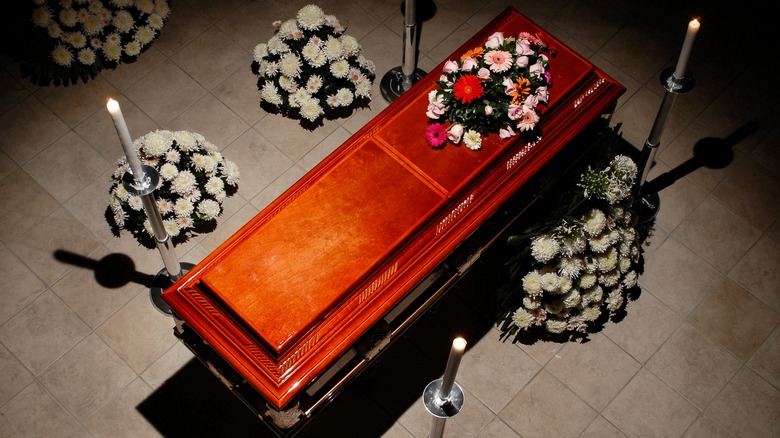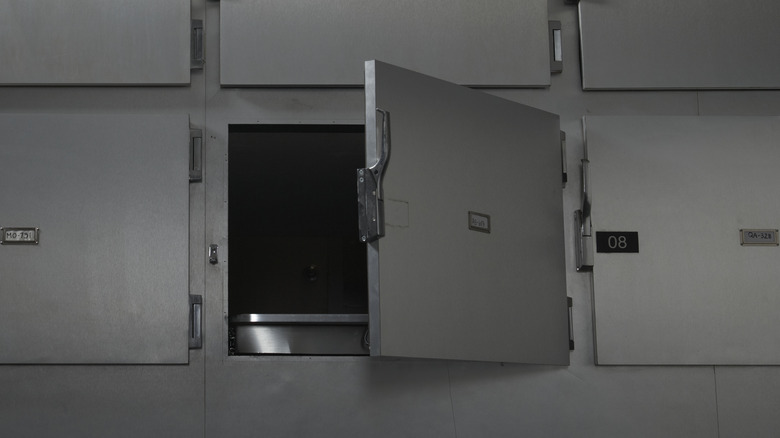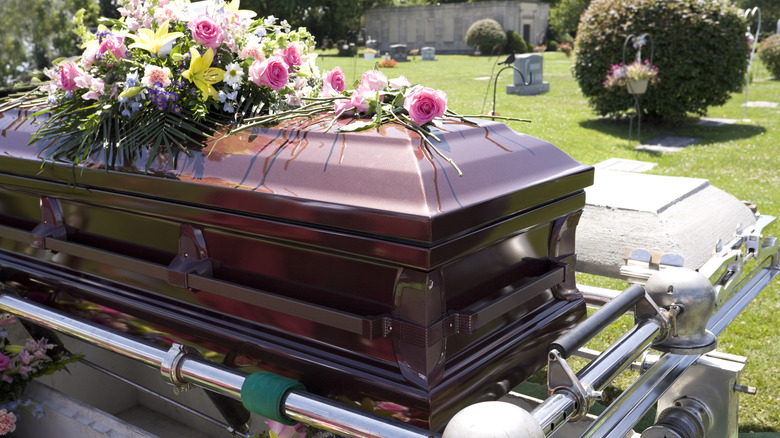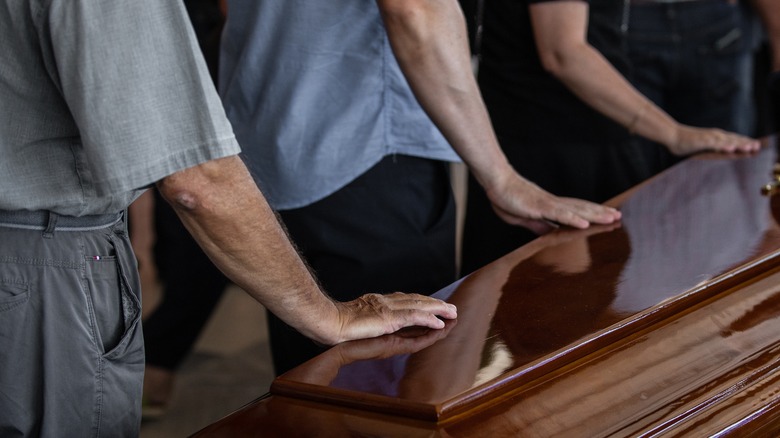The 5 Most Disturbing Cases Of People Waking Up In A Coffin
It's the stuff of nightmares and horror films: Waking up in a coffin or at your own funeral — or worse, buried underground or in a tomb. Although a person seemingly reviving in the morgue or in a coffin is vanishingly rare, it does happen, and it's more common than you might think, according to Insider. As Dr. Stephen Hughes, a senior lecturer in medicine at Anglia Ruskin University told the outlet, it's happened to him twice in his 20 years practicing medicine. Speaking with Insider, Hughes called one of those cases "quite freaky" — that's an understatement.
Sadly, most individuals who seem to come back to life after they've been mistakenly declared dead don't make it. (In Hughes' own experience, one person recovered, to the best of his memory, while the other one later died.) There are also a few reasons why it might happen, Hughes said, including certain types of drug overdoses mimicking death, inadequate medical care, or the fact that death itself is more like a process rather than one single event.
To that point, Hughes added, "Different body systems shut down at different rates and so it is not unusual to still hear a few bowel sounds around or even just after the time of death. This can cause confusion by masking quiet heart sounds." From possibly waking up inside a concrete tomb to movement detected at the morgue, here are just five of the most disturbing cases of people who seemed to revive on their own after everyone else thought they died.
A woman in Ecuador woke up at her own wake
In mid-June 2023, the Associated Press reported a 76-year-old Ecuadorian woman name Bella Montoya woke up in her coffin at her own wake. Montoya was declared dead at an Ecuadorian hospital from a possible stroke and cardiopulmonary arrest, but in the middle of her wake, attendees heard a knocking sound from her coffin; she was alive. Montoya's son Gilberto Barbera, who was there, told the AP, "It gave us all a fright."
"There were about 20 of us there," Barbera continued. "After about five hours of the wake, the coffin started to make sounds. My mom was wrapped in sheets and hitting the coffin, and when we approached we could see that she was breathing heavily." Montoya was readmitted into intensive care. As of this report, Montoya's prognosis was unclear, and what caused her to be incorrectly declared dead was still under investigation.
A woman in Iowa was found gasping for air inside her body bag
Earlier in 2023, The New York Times reported a 66-year-old Iowa woman was declared dead at an Alzheimer's care center, only to later be discovered alive and struggling to breathe once her body bag was unzipped. She was admitted into the facility two years earlier, diagnosed with early-onset dementia, anxiety, and depression. As her health declined, she was moved to hospice care. She was declared dead when care center staff found her unresponsive.
According to a report from the Iowa Department of Inspections and Appeals (DIA) on the matter (via CNN), the nurse who found the woman unresponsive failed to detect a pulse or see any movement from her abdomen. Her mouth was open and her eyes were fixed, the report said. After she was transported to the funeral home, "staff unzipped the bag and observed Resident #1's chest moving and she gasped for air. The funeral home then called 911 and hospice," the DIA wrote.
Once discovered alive, she was then returned to hospice care at the Alzheimer's facility. She sadly died two days later. The center was reportedly fined $10,000 for the mistake.
A Honduran teen was reportedly heard screaming from inside her coffin
Though later declared officially dead for a second time, in 2015 the Irish Examiner reported a Honduran family heard Neysi Perez, a deceased teenage relative, screaming from inside her coffin. It was sealed inside a concrete tomb that her family smashed open to try and rescue her. Her first death declaration came after the 16-year-old, who was pregnant, collapsed and began foaming at the mouth.
Once outside the concrete tomb, the glass on her coffin was found cracked, Neysi's fingers were bruised, and there were scratches on her forehead, consistent with a struggle to escape. Although there were no vital signs once Neysi was returned to medical care, both her young husband and an unnamed cemetery worker supported the claims she could be heard screaming and banging from inside the tomb.
Carolina Perez, Neysi's cousin, also reported a faint heartbeat when Neysi was rescued. "It looked like she had tried desperately to get out of the casket," Carolina said. According to Dr. Claudia Lopez, Neysi was once more declared dead and returned to the cemetery. Medical professionals said she may have at first only appeared dead — and likely really did die later on from lack of oxygen.
A man in Peru showed signs of life at his open casket funeral
In 2017, Watson Franklin Mandujano Doroteo, a young Peruvian man, showed signs of life in the middle of his own open-casket funeral, The Independent reported. Family members reportedly saw him breathing at the wake, and vital signs were confirmed by a medical professional. Doroteo was declared dead the first time following a dental procedure, but family members later theorized the diazepam — more commonly known as Valium — given to Doroteo during the root canal may have caused him to only seem dead.
Writing in The Conversation, Dr. Stephen Hughes said both diazepam and alprazolam — or Xanax — are known to sometimes create the illusion of death. "[A]n overdose of sedatives reduces responsiveness and depresses the breathing and circulation, leading to the impression of death while protecting the brain from hypoxia (oxygen starvation). Later on, as the drug is cleared from the body, the person may wake up," Hughes wrote. Once Doroteo was returned to the hospital, he was confirmed dead a second time.
A man in Mississippi woke up as he was about to be embalmed
In 2014, Walter Williams, a 78-year-old man in Mississippi, began moving his legs and kicking inside his body bag as he was about to be embalmed, CNN reported. Williams was in hospice care before he was declared dead the first time, and after he was found to still be alive, he really did die two weeks later.
According to Holmes County coroner Dexter Howard, who pronounced Williams dead the first time (via CNN), "We got him into the embalming room, and we noticed his legs beginning to move, like kicking. He also began to do a little breathing." A faint heartbeat was also picked up on a monitor. Howard referred to Williams' situation as a miracle.
According to Dr. Stephen Hughes (via The Conversation), occasional mistakes declaring someone dead explain the old naval custom of stitching one final stitch of a dead seaman's body bag through his nose — if that doesn't wake him up, nothing will. Per The Guardian, premature declarations of death were far more common in the 19th century, and a major preoccupation of writer Edgar Allen Poe — after a closer look at just a few recent cases, it's easy to understand why.





